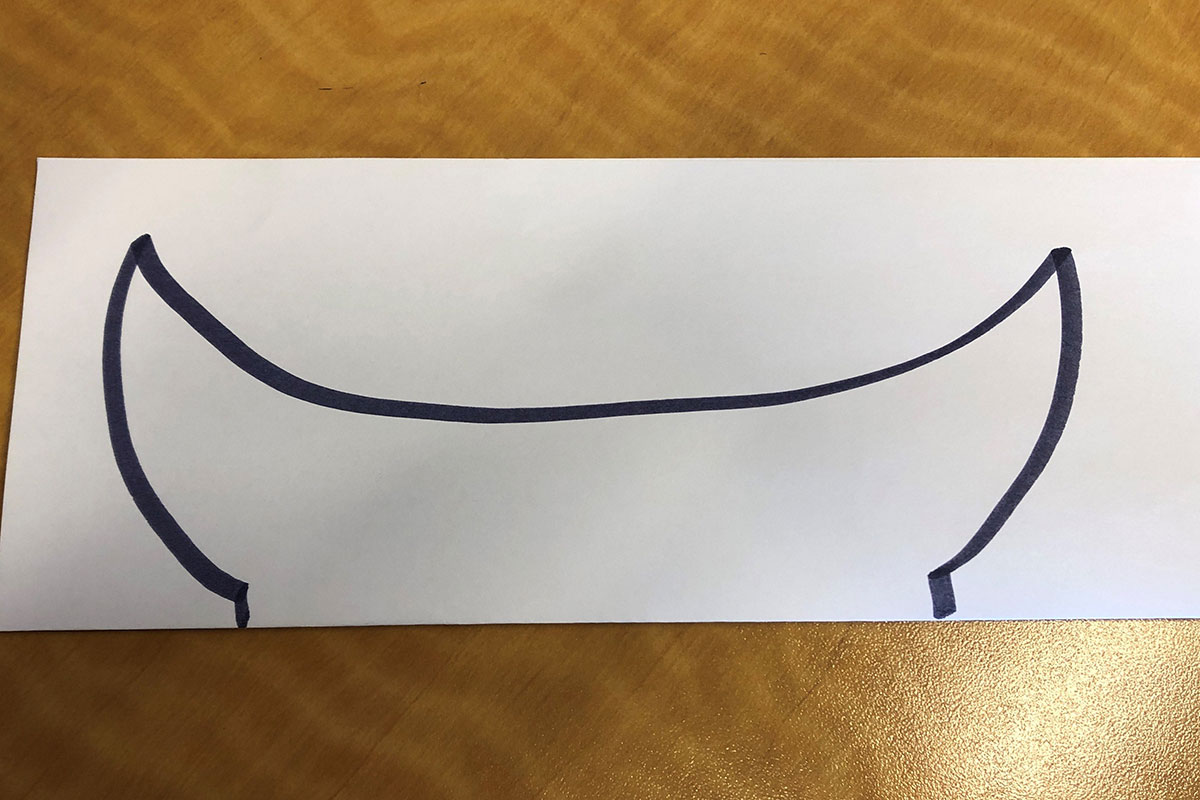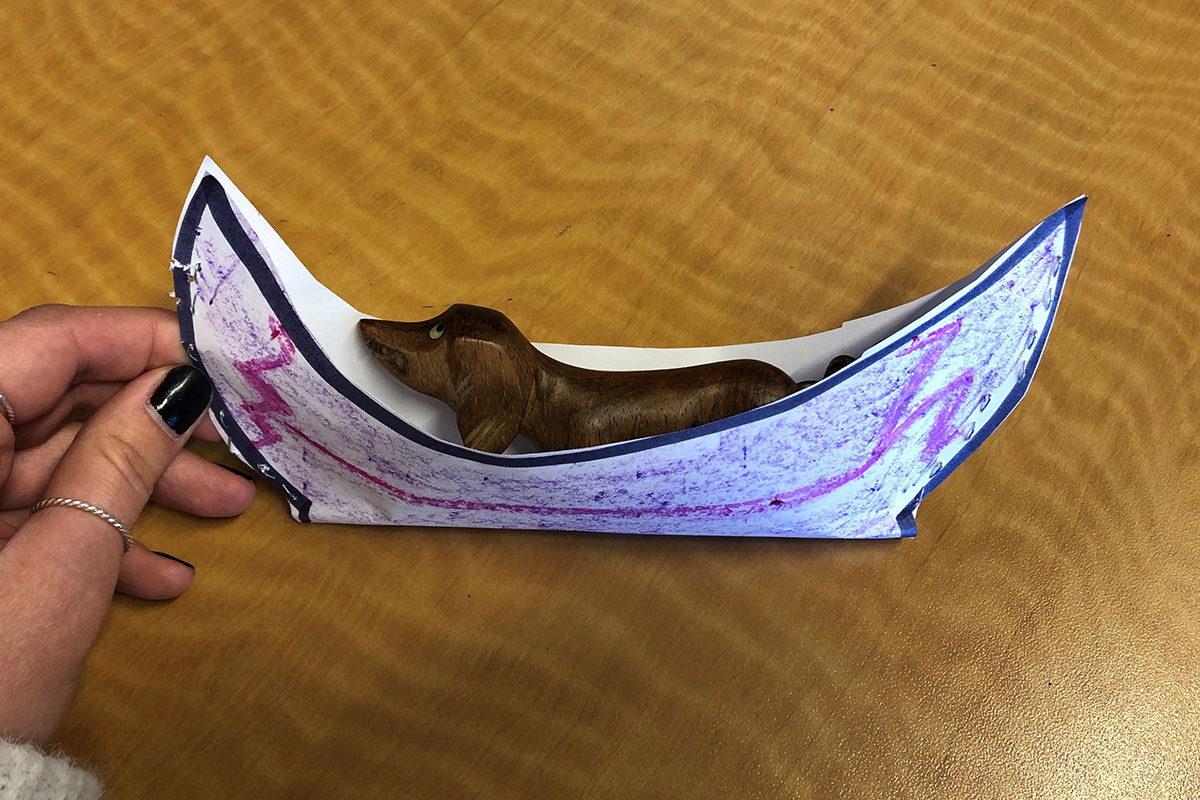Turtle Island - Day 1 - The Coast
These activities can be done alone, but work best with one or more friends on a video chat like Skype, Zoom, Facetime, etc.
Grades K-3
Grades K-3
Mindfulness Activity
Trivia Question: On average, how much does a pacific halibut fish weigh?
a) 100 pounds
b) 200 pounds
c) 500 pounds
Mindfulness Activity:
- Put your palms together at chest height.
- Push your hands against each other as hard as you can.
- Which muscle gets tired first?
Fishing Game
Supplies:
- Paper
- Scissors
- String
- Fishing pole (can be a stick or tightly rolled paper)
- Metal paper clips
- Crayons
- Magnet
Fish are an important source of food for communities that live along the coast. Traditionally, Salish people use nets, hooks, spears and traps to catch fish that could be as big as a whale or as small as a shrimp.
Have your child make some fish.
- Fold a couple of pieces of paper in half.
- Draw the shape of a fish and cut it out.
- Decorate the fish to look like salmon, trout, halibut, or other fish found on the coast.
- Glue the two pieces together with a metal paperclip in the fish’s mouth.
Have your child make a fishing pole.
- Attach a piece of string to your fishing pole.
- Attach a magnet to the end of the string.
Go fishing in your living room! Try to catch your fish with the magnet.
Build a Canoe
Supplies:
- Paper
- Scissors
- Crayons
- Stapler
- Mod podge
Turtle Island is a name many Indigenous peoples use for North America. Indigenous peoples along the NW coast of Turtle Island built canoes from 300-800 year old western red cedar trees. Choosing the tree was very important to the type of canoe they were building.
Have your child fold a piece of paper in half. Draw a canoe on one side of the paper so the bottom is along the fold. Cut out the canoe shape. Colour and decorate your canoe.
Secure the sides with staples or glue. If you have mod podge at home, seal your canoe to keep it more water resistant.
Try out your canoe in your bathtub or sink. Can you think of any other ways you could try building a canoe?


Make Your Own Rocks
Supplies:
- Sand
- Glue
- Pebbles
- Disposable clear cups
Rocks are sometimes called ‘grandfathers’ since they are so old. For geologists, rocks tell us a story about the Earth’s history. For Ingenious peoples, rocks can teach us valuable lessons. Rocks can be used for important ceremonies or to mark sites for celebrations.
Have your child layer the different materials in a cup. Add sand, thin layers of glue, then pebbles. Repeat until the cup is about one third full.
Wait for a week for your rock to dry. When almost dry, cut your rock out of the cup and add pieces of pebbles where the glue wasn’t fully dry. Leave it out in the sun to fully dry.
Review Questions
Ask your child:
- How do you feel when you are close to the water? (Feel)
- What types of supplies do you think you would need to live on the coast? (Think)
- Where is somewhere with water that you’d like to visit or learn more about? (Act)
Mindfulness Trivia Answer
Answer: c) 500 pounds
Grades 4-6
Grades 4-6
Mindfulness Activity
Trivia Question: True or False? Totem poles are carved by all First Nations peoples in Canada.
Mindfulness Activity:
- Put your palms together at chest height.
- Push your hands against each other as hard as you can.
- Which muscle gets tired first?
Totem Poles Facts
Supplies:
- Paper
- Colouring items
A totem pole is a tall structure created by Northwest Coast Indigenous peoples. They showcase a nation’s, family’s or individual’s history and displays their rights to certain territories, songs, dances and other aspects of their culture. Totem poles can also be used as memorials or to tell stories.
Have your child watch the totem pole video. Write down 4-6 things you learned about totem poles.
Create a poster or flyer about totem poles.
Take a picture of your poster or flyer and send it to 3-5 friends or family members to share what you learned.
Salmon Mobile
Supplies:
- A closet hanger
- Yarn
- Watercolour paint
- Cardboard
- Scissors
- Hole punch
The Coast Salish people of the Canadian Pacific Coast have depended on salmon as a main food source for thousands of years. Salmon has also been a source of their wealth and trade. It is deeply embedded in their culture, identity and existence.
Have your child draw 4-6 salmon (between 6 and 2 centimeters long) on white paper. Paint them with watercolours and let them dry. Make a hole on one of the ends.
Wrap a closet hanger with yarn (you can use different colours).
Cut 4-6 pieces of yarn of different lengths (10 to 25 cm long). Tie one end of each string to the salmon paintings and the other end to the widest side of the hanger.
Kwakwaka'wakw Art
Supplies:
- Camera and printer (if available)
For the Kwakwaka'wakw people, art is a visual picture of who they are and where they come from. Everything has a history and a purpose. Have your child take a virtual tour to admire the art of the Kwakwaka'wakw people.
Click on one piece of art you like and read the background. What does it say? What colours are mostly used? Why was this important?
Think about objects, photos or art around your house that are important or significant to you and your family. What is its story? Why is it important?
Take pictures of these items, print them and write why they are important on the back.
Review Questions
Ask your child:
- How does art make you feel? (Feel)
- How would your lifestyle change if you lived by the ocean? (Think)
- What can you do in the future to appreciate art in a different way? (Act)
Mindfulness Trivia Answer
Answer: False. Only 6 west coast First Nations carve totem poles.
Grades 7+
Grades 7+
Mindfulness Activity
Trivia Question: How far away from Earth is the sun? See Answer below
- A: 150 thousand km
- B: 150 million km
- C: 150 billion km
Mindfulness Activity:
- Lay on your back.
- Breathe and listen to the sounds your lungs make.
- Notice your pulse and the sounds you hear around you.
The Kwakwaka'wakw Language
Supplies:
- Paper
- Pencil
- Markers
- Camera
The Kwakwaka'wakw (pronounced: KWOK-wok-ya-wokw) of British Columbia have a rich culture that reflects and honours our natural environment.
Kwakʼwala, previously known as Kwakiutl, is the language spoken by the Kwakwakaʼwakw. There are less than 200 fluent Kwakʼwala speakers today (only 3% of the Kwakwakaʼwakw population). The language is officially endangered, but they are working hard to keep it alive.
The alphabet includes 43 characters. Learn what each character looks and sounds like.
With a friend or family member, take turns trying to pronounce each character. The other person will try to recognize which character it is and try writing it down. Switch roles so you both get a chance to hear and guess the character. Whoever is able to recognize the most characters is the winner.
West Coast Art
Supplies:
- Paper
- Pencil
- Markers
- Paint
Choose 3-5 artists from the Spirits of the West Coast Gallery and explore their artwork. How do you see the natural world reflected in their art?
Think about what your environment, or even the neighbourhood you grew up in, has (mountains, rivers, etc.). Create your own style of images that reflect your experiences with the natural world.
Share your picture with your friends and family. Let them know what motivated you to capture this scene.
One World (We Are One)
Music and spoken word poetry are ways Indigenous peoples have supported ideas and shared their stories.
The video called “We Are One” was produced by IllumiNative and Mag 7. The song focuses on finding unity in through diversity. Although we may come from different cultures, we as humans all live in this one world where we live together.
Watch the music video. Try to write your own lyrics or try spoken word poetry to describe what it means to have one world and be unified together regardless of our differences.
Share your work with friends and family.
Review Questions
- How did you feel about learning a different language? (Feel)
- How do you think art is connected to your own culture? (Think)
- What are ways you can advocate for all cultures to be unified? (Act)
Mindfulness Trivia Answer
Answer: B: 150 million km (147.2 million km to be exact)

